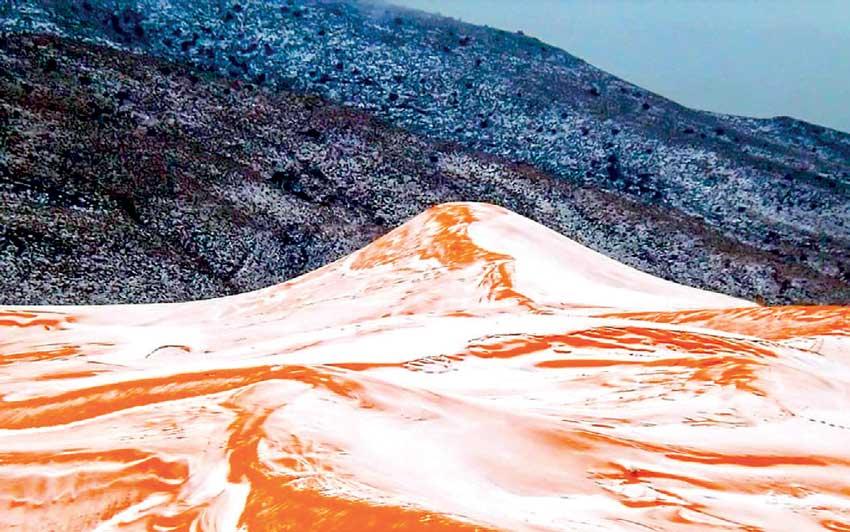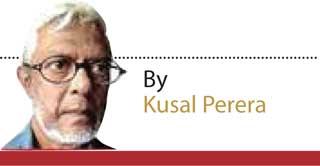29 Jan 2022 - {{hitsCtrl.values.hits}}

Snowstorm in Sahara for first time in 37 years
 “Sahara” the warmest and the largest desert on planet earth reported snowstorms on 18 January last. Spread across 9.2 million sq. km stretching from parts of North Africa, the Atlas Mountains of the Maghreb or Northwest Africa to the Nile valley of Egypt and Sudan, Sahara Desert have had four snowstorms since the first reported in 1979 over 42 years ago.
“Sahara” the warmest and the largest desert on planet earth reported snowstorms on 18 January last. Spread across 9.2 million sq. km stretching from parts of North Africa, the Atlas Mountains of the Maghreb or Northwest Africa to the Nile valley of Egypt and Sudan, Sahara Desert have had four snowstorms since the first reported in 1979 over 42 years ago.
This Sahara snowstorm for whatever reason did not grab much importance and coverage in our local media. Neither in our social media. Most international media were mesmerised by the “beauty of the snow-capped sand dunes” and made it a photojournalistic adventure. BBC on 20th January (2022) carried the news with the headline “In pictures: Snow falls in Algeria’s Sahara Desert”. Same day, “The Indian Express” titled their report “Phenomenal: Photos of snow-covered Sahara desert wows all online”. Despite its awesome beauty, something “unnatural” was happening to have snowstorms in a
desert amidst sandstorms.
Since the first snowstorm in 1979, there had been a very long interval of 37 years before the second in 2016. Of the five snowstorms, the last four snowstorms, including this 18 January snowstorm, was within around five years.
The reason for these snowstorms to be so frequent during the past five years is presumed to be “Global Warming and Climate Change”. The Russian news agency TASS had quoted Roman Vilfand head of “Federal Service for Monitoring Environment” accepting extreme weather situations, “including snowfalls in the Sahara, a long cold spell in North America, very warm weather in the European part of Russia and sustained rains which sparked flooding in Western European countries, have been occurring more frequently” due to“….global warming”. It is “an opinion shared by members of the Intergovernmental Panel on Climate Change (IPCC).” Vilfand had said.
This 40-year-old global free-market economy was shattered in no time in early 2020 by the COVID-19 pandemic. Governments closed their national boundaries. Investments lost mobility. Trade and labour migration came to a halt. Airlines were grounded. Shipping is severely restricted
Global Warming with Climate Change, a major tragedy by now was first brought to global attention in 1992 at the UN Conference on Environment and Development in Rio de Janeiro, Brazil. Thirty years ago, the preamble to “Agenda 21” adopted by 178 countries in Rio de Janeiro began with the sentence “Humanity stands at a defining moment in history”. It then says, “We are confronted with a perpetuation of disparities between and within nations, a worsening of poverty, hunger, ill-health and illiteracy, and the continuing deterioration of the ecosystems on which we depend for our well-being”.
These serious “negative developments” demanding quick collective actions surfaced with the “petro-dollar crisis” in early ‘70s. With US and other countries like Germany, Venezuela, Iran, gaining peak oil production by 1973, pressure was on OPEC to stabilise world crude oil prices. The US deciding in 1973 to provide fuel to Israel military during the Yom Kippur War led Organisation of Arab Petroleum Exporting Countries (OAPEC) to declare an “oil embargo” on the US and countries supporting Israel. Decade of 70 thus came to an end with OPEC controlling oil prices that created a dual effect in most European and American countries. Economic growth became stagnant while inflation increased that created the word “stagflation”.
These economic and political conflicts played a catalyst in turning the world economy into a global free market, dismantling national geographical borders for investments, trade, and labour migration.
This 40-year-old global free-market economy was shattered in no time in early 2020 by the COVID-19 pandemic. Governments closed their national boundaries. Investments lost mobility. Trade and labour migration came to a halt. Airlines were grounded. Shipping is severely restricted. National economies became important.
But mega business monopolies that grew within free markets pushed for pre-Covid “normalcy” for bigger “profits”.
This led to discussions on what “post-Covid world” should be. The debate first centred on “pre-Covid normalcy” that needed new branding to be accepted and was called “new normalcy”. It sought two different interpretations. One by the “World Economic Forum” summit in Davos dominated by mega business monopolies and governments of the first world backed by the same profiteering mega businesses. At the virtual summit held from 17 to 21 January (2022) the “Davos Agenda 2022” camouflaged their focus on market expansions and profits. They carried plenty of rhetoric hovering around popular issues like poverty, employment, climate action, risk factors like COVID-19, vaccination rollouts and concepts like stakeholder capitalism, liberal democratic capitalism, rebuilding trust on a new social contract and many more.
Outside Davos, there is another “new normal” being discussed. That is fundamentally about the preamble to “Agenda 21” that 30 years ago warned of perpetuating disparities between and within nations, of worsening poverty, hunger, ill-health and illiteracy, and the continuing deterioration of the ecosystems. It was about free-market economies that kept increasing climate change and global warming the Russian environmentalist Roman Vilfand attributed to “extreme weather” conditions including Sahara snowstorms.
The new debate thus focuses on 40 years of neoliberalism in global free-market economy when “normalcy” was about (1) massive disparities in distribution and accumulation of wealth and income (2) widespread violence of majoritarian extremism in curbing fundamental rights and dignity of minority communities in poor and developing countries (3) continuing devastation of forests and ecosystems with increased floods, long spells of drought and landslides adding more to global warming and climate change and then resulted in (4) turning the State into an oppressive mechanism restricting fundamental rights and democratic space. Pre-Covid “normalcy” therefore was about free markets heaping tragedies on society while the urban middle class turned into rich and greedy customers.
The alternate “new normal” thus promotes (01) gradual but continuous flattening of anomalies in wealth and income distribution (02) democratising of the nation State as inclusive and secular (03) strengthening national economies with identified priorities for investments and development and most importantly (04) safeguarding environment and eco-systems in reducing Carbon emissions and in controlling and managing global warming and climate change.
Sadly for Sri Lanka, “new normalcy” is neither with “Davos” nor with the “alternate”. Davos too accepts some sanity in “profiteering” instead of wild grabbing of everything possible, though in praxis it would be that in developing and
poor countries.
Most developing and poor countries will be no different to Sri Lanka lives with pledges and commitments strictly on paper as it is with the “Nationally Determined Contributions” (NDCs) presented in July 2021 to “United Nations Framework Convention on Climate Change (UNFCCC)”.
While caught in the Covid pandemic, the NDCs in 2021 pledged to focus “on building the resilience of Agriculture, Fisheries, Livestock, Health, Water, Biodiversity, Coastal and Marine, Tourism, Urban Planning and Human Settlement sectors”. And among many others to “reduce greenhouse emissions by 14.5% for the period of 2021-2030 from Power (electricity generation), Transport, Industry, Waste, Forestry, and Agriculture”.
We all know how hilarious this pledge for NDCs is. We all know how forests are denuded. How coastal areas are polluted.Though the NDCs accept “In 2016 and 2017, Sri Lanka’s economy contracted due to prolonged drought and widespread flooding. Climate change projections predict long-term changes to the monsoon pattern and shifting of ecological regions.” (Executive Summary) more damage is allowed in forests and coastal areas with unsolicited projects seeking more profits.
While politics in Sri Lanka is defined and designed by the “filthy rich”, products of the free market economy, governments do not and cannot change course to honour pledges to international forums and NDCs stand violated. The ‘Coastal Zone and Coastal Resource Management Plan 2018’ valid till 2023, says “Expanding tourism industry” is the third of the 07 factors in coastal pollution. “The development of tourism sectors has led to an increase of structures along the coastline and increased pollution of beaches and coastal waters.”
Two or three days ago Mahinda Amaraweera, Minister of Environment on a tour of Mahaweli areas in Kandy district was shown umpteen number of illegal constructions, mostly tourist hotels, guest houses and restaurants along the Mahaweli river, that destroy its environment and eco-habitats. He accepted they are politically sponsored and carry big money with them. It is therefore not just beaches and offshore areas that are polluted and devastated by Tourism promoted as a major forex earner.
Local government bodies have not identified and demarcated residential and commercial areas within their jurisdictions when approving constructions. Nor have the UDA, at least in practice. Wonder how “resilience of Biodiversity, Coastal and Marine, Tourism, Urban Planning and Human Settlement sectors” are focused upon with no plans in hand.
We yet continue with no discussions on what our “normalcy” should be in post-Covid Sri Lanka. Instead, “economists and financial experts” keep providing textbook answers that do not define post-Covid normalcy. Our problem is, even “experts” have no clue what “normalcy” in post-Covid Sri Lanka should be. They play with the filthy rich trying to fix issues for a pre-Covid Sri Lanka in a global free-market economy.
28 Nov 2024 1 hours ago
28 Nov 2024 2 hours ago
28 Nov 2024 3 hours ago
28 Nov 2024 3 hours ago
28 Nov 2024 5 hours ago